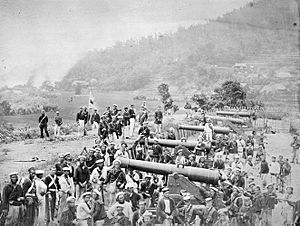Genji facts for kids
Genji (元治) was a special name for a period of time in Japanese history. It was like a "year name" or nengō. This era came after the Bunkyū period and before the Keiō period. The Genji era lasted for just over one year, from February 1864 to April 1865. During this time, the emperor of Japan was Emperor Kōmei. The name Genji means "original rule."
Contents
Important Events of the Genji Era
The Genji era was a time of big changes and conflicts in Japan. Here are some key events that happened:
Ikedaya Incident
- July 8, 1864 (Genji 1, 5th day of the 6th month): A fight happened at a place called Ikedaya, near Kyoto. This event is known as the Ikedaya Incident. Samurai who supported the emperor fought against the police forces of the Tokugawa shogunate. The shogunate was the military government that ruled Japan at the time.
Sakuma Shōzan's Death
- August 12, 1864 (Genji 1, 11th day of the 7th month): Sakuma Shōzan, an important thinker and scholar, was killed when he was 53 years old. He was assassinated by groups who were against the shogunate. These groups believed in "sonnō jōi," which meant "Revere the Emperor, Expel the Barbarians." They wanted to restore the emperor's power and remove foreign influences from Japan.
Bombardment of Shimonoseki
- September 5-6, 1864 (Genji 1, 5th-6th day of the 8th month): The city of Shimonoseki was attacked by ships from several Western countries. This event is known as the Bombardment of Shimonoseki. It happened because a Japanese domain had fired on foreign ships passing through the area.
Related History
See also
 In Spanish: Genji para niños
In Spanish: Genji para niños

All content from Kiddle encyclopedia articles (including the article images and facts) can be freely used under Attribution-ShareAlike license, unless stated otherwise. Cite this article:
Genji Facts for Kids. Kiddle Encyclopedia.

